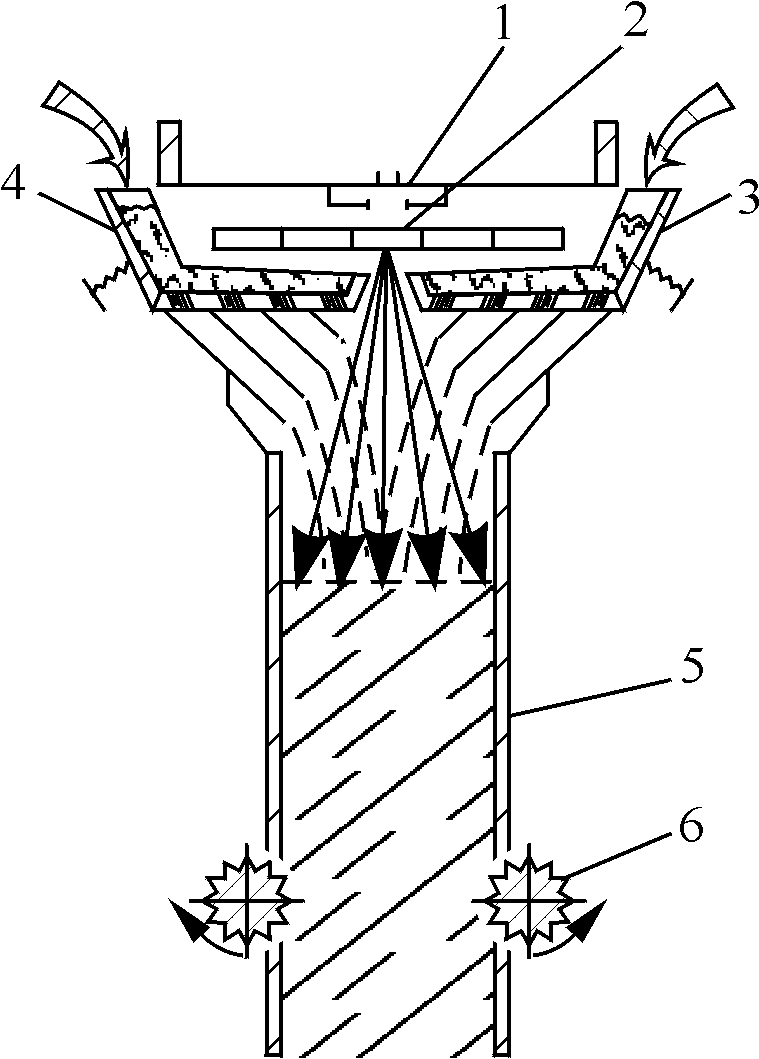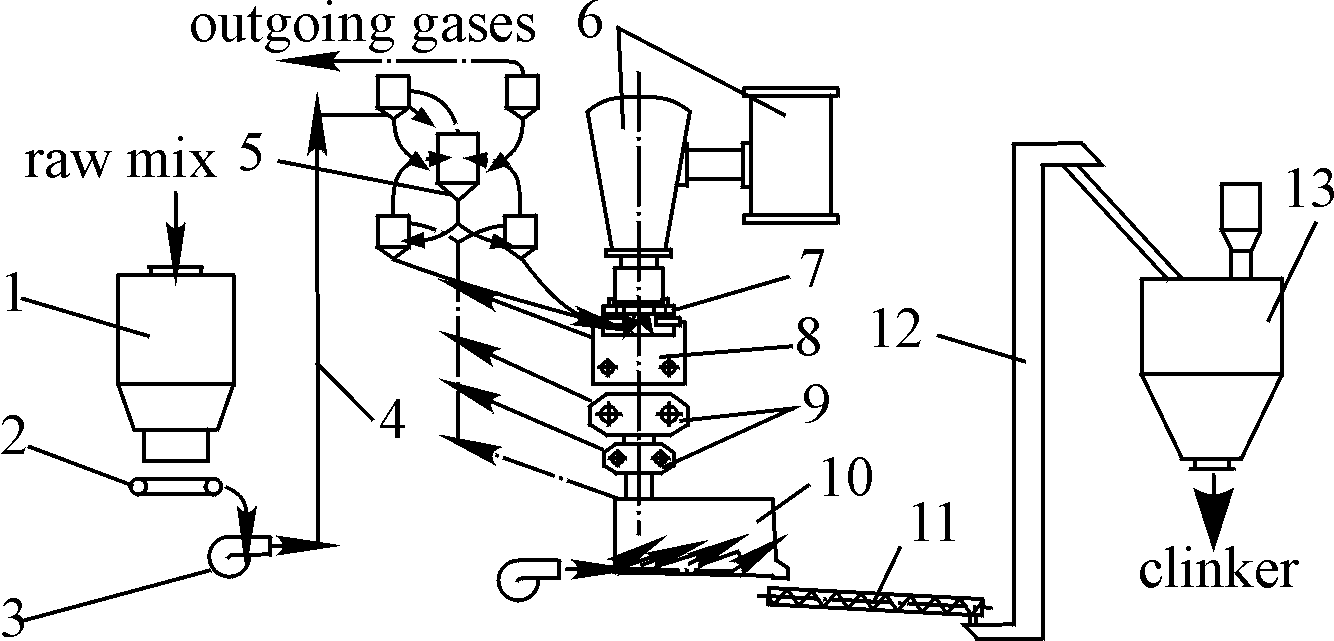
THE DESIGN OF PILOT LINE FOR CEMENT CLINKER PRODUCTION BY RT-TECHNOLOGY
Abramson I.G., Egorov G.B. and Nikiforov Yu.V.
Institute “Giprocement-nauka”, St.Petersburg, 193224, Russia
ABSTRACT: The design of demonstrating technological pilot line for cement clinker production by principle new RT-technology is presented. The peculiarities of the clinker production by this way are shown. The economical and ecological aspects of RT-technology are discussed.
Key words: cement clinker, RT-technology, electron accelerator.
1. INTRODUCTION
Radiation thermal (RT) way of cement clinker production based on the usage of the powerful beams of accelerated electrons as the source of energy has been suggested in the 1970th years(1). Despite of the far-off perspectives of industrial realization (mainly due to the insufficient power of the recent accelerators and relatively high prime cost of generated energy) the development of cement technology on the base of RT way was stimulated by energetic and ecological situation and by the need in the intensification of cement production. At present the fundamentals of RT technology are possible to consider as already developed. Among the number of electro-technological methods RT is one of the most effective as it provides practically unlimited concentration of energy, the introduction it into the bulk of material (on the depth of the electron range) and as the consequence the heating of the raw material to the temperatures of clinker formation in a seconds in the conditions closed to the adiabatic. Now the technological scheme of pilot line with 0,5 t/h capacity is proposed.
2. EXPERIMENTAL
At the initial laboratory stage of work on the accelerators up to 20 kW the kinetic properties of RT clinker formation and the main interrelations between chemical-mineralogical composition and the structure of the clinker, energetic parameters of the clinker formation process and the quality of the cement obtained have been studied (2).
For the further improvement of RT-technology of cement and other energy capacity products an experimental device on the base of industrial accelerator with a power of electron beam up to 100 kW and the energy of electrons up to 1,5 MeV has been put into operation in Novosibirsk (3). The accelerator alongside with the emission of electron beam through the foil has a system of concentrated emission through the aperture of a small diameter. The concentrated emission system is much more perspective for the high temperature processes.
A number of constructions of radiation-thermal apparatus (RTA) for the clinker synthesis in a beam of electrons have been tested on this device. The shaft type of RTA proved to be most effective. It provides the translocation of material particles from the surface into the depth of radiation zone (Fig.1) and in result obtaining a product more uniform in properties with minimal energy costs. Applied to shaft apparatus the questions of uniform distribution of raw flow and electrons along the surface of radiation zone, of the interaction of chemically active clinker obtained with elements of RTA are excluded. The generation of ozone is practically eliminated because the air between output window of accelerator and the surface of irradiated material is repressed by СО2 atmosphere. The systems of formation of radiation fields of rectangular type, providing the coefficient of beam power use about 80% in space were established.

Fig.1. The shaft type of RTA 1
1 –output window of accelerator; 2 – beam scanning device; 3, 4 - powder sprayers; 5 – shaft; 6 – clinker transport device
3 RESULTS AND DISCUSSION
To the number of main results of laboratory stage of work should refereed the discovery of the effect of radiation (super-thermal) activation of solid phase interaction in the process of clinker formation which alongside with the realization of known advantages of rapid burning sharply intensifies the process in a whole.
Experimental data obtained in the investigations of chemical-technological interrelations of RT clinker formation on the apparatus of shaft type coincide in the main with the conclusions made earlier (1, 2) on the laboratory stage. It was confirmed that from the viewpoints of even changes of size the safe limit of free lime content in RT clinkers comprise 3,0-3,5%. At the same time in burning in the kiln the clinker with the free CaO content = 1,7% have not stand the test on the even changes of size.
The phenomenon of over-radiation which was found out in the laboratory experiments and is characterized by the decrease of RT clinkers activity with occurrence on the micro-sections fused zones with large acicular alite crystals 200 µm and more takes place in clinkers obtained in the shaft type RTA. However the decrease of activity is observed when significant part of the micro-sections space has the structure of fused clinker and maximum size of alite crystals attain 700 µm and above.
The relationship of RT clinkers activity obtained on the experimental device and their alite content is linear and rather strong for clinkers without signs of over-radiation. With the increase of alite content the activity of these clinkers on all timings of hardening increases on 10-20 MPa.
Exposure of material under maximal temperature after completion of radiation practically always promote more complete proceeding of clinker formation processes. From the other hand rapid cooling of clinker after indicated exposure totally removes such unpleasant phenomenon as alite decomposition.
Conditions of rapid heating of raw mixture by the electrons beam with following (during several minutes) exposure of material under high temperature and then fast cooling of clinker after its grinding most effectively are realized in the RT apparatus of shaft type.
Detailed discussion of experimental results is given in (3).
4. PILOT LINE: PROJECT AND PROPOSALS
The experience got in experimental device was used in creation of pilot demo line with production capacity up to 0.5 ton per hour. The scheme of the device is shown in Fig. 2. From the bunker 1 the raw mix after the weighting batcher 2 by means of pneumatic pump 3 along the system of pneumatic transport 4 is fed into three-stage two branched heat exchanger 5. In the latter a raw mix is heated up to 400?C by outgoing gases from radiation-thermal apparatus, grinding and cooler. After being processed by electron beam generated by accelerator of 500kW power 6 and formatted at the output from accelerator by the scanning device 7, the raw mix flows into the RTA 8 along incline canals through the batcher and transforms into the clinker block. After the emergence from the RTA it is grinded into two-chambered grinding device 9 and goes into the cooler 10 where it is cooled by compacted air and then with screw conveyer 11 and elevator 12 is transported to the bunker of ready product 13. The control over the work of accelerator, RTA and technological devices is automated and supplied with video control.
The physical start of demo line was planned on the end of 1991. However, all works have been canceled from the January 1991 due to the lack of financing.

Fig.2. Technological scheme of pilot line
5. CONCLUSIONS
Radiation-thermal technology is based on the opened in 1970-80th years phenomenon of radiation-thermal activation of solid-phase chemical reactions in non-organic systems. The basic advantages of the radiation technology are as follows:
Despite all indicated advantages, in the economic relation radiation-thermal technology of common cement forms would become competitive to the modern dry method of production there and then where and when the share of conventional electric power plants appear to be less than 50% of the general electric energy balance of the country. That is why it is expedient the first experimental-industrial technological lines to orient on the production of expensive special kinds of cement by radiation-thermal method.
From the ecological point of view the radiation-thermal technology currently if it was worked out in industrial conditions would be out of competitions. It should be kept in mind that every year demands of environment protection would increase and correspondingly would increase expenses spend on the environmental protection means and therefore prime cost of the product increase. One of the global problems is the struggle with the hotbed effect, caused by the increasing production of carbonic gas. In result the objective tendencies towards curb of introductions new conventional electric power plants and propellant capacious productions (see Kioto Protocol, 1997).
These factors can call for the radiation-thermal technology as inevitable alternative to the classical one in the XXI century.
Therefore, it is important to restore the works on creation of pilot demo line for cement clinker production by RT-technology. In October 2000 China Building Materials Academy has proposed to build this line based on the new 500 kW electron accelerator on the territory of Academy in Beijing. The problem to be solved is financial one.
REFERENCES
1. Abramson I.G. et al. Radiatsionno-himicheskiy sposob polucheniya portlandcementnogo clinkera. Cement, 1976, 9: 6-7.
2. Abramson I.G. et al. Osobennosti formirovaniya tekhnicheskih svoystv portlandcementnogo clinkera, poluchennogo v moshchnyh potokah uskorennyh elektronov. Zhurnal phizicheskoy himii, 1984, 58(5): 1100-1103.
3. Abramson I.G. et al. The fundamentals of the radiation-thermal technology for cement production. In “RadTech Asia-95 Conference. Proceedings”, Guilin (1995)
P.S. "Компания открытых систем" приглашает всех заинтересованных лиц (инженеров, научных работников и др.) дать свои комментарии по поводу данной статьи и прислать их наш email:
Sirine@mail.ru. Наиболее интересные статьи, высказывания обязательно будут опубликованы на нашем сайте.
.
Только подписка гарантирует Вам оперативное получение информации о новинках данного раздела
Нужное: Услуги нянь Коллекционные куклы Уборка, мытье окон